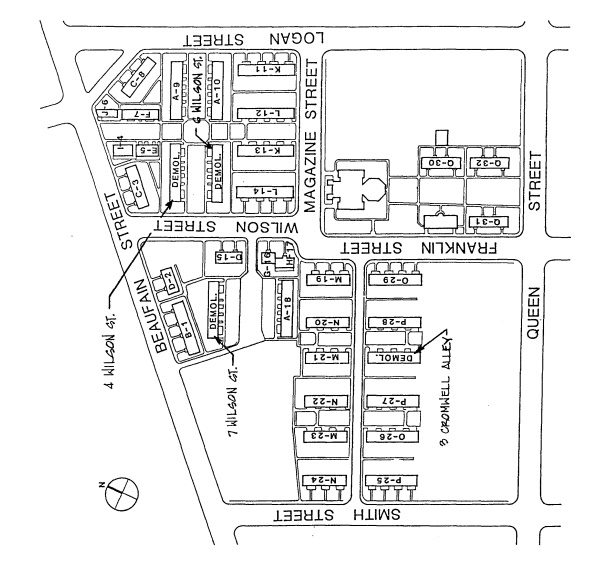- City:
- Charleston, SC
- Site Type:
- Public Housing, Civic Facilities
- New Deal Agencies:
- Housing Programs, Federal Housing Administration (FHA)
- Started:
- 1938
- Completed:
- 1941
- Marked:
- Unknown
Description
By the early twentieth century, the area that would become the Robert Mills Manor site consisted of a large assemblage of dilapidated late-19th and early-20th century residences and tenements surrounding the county’s jail on the corner of Franklin and Magazine Streets. Conditions at the site had deteriorated to the point where contemporary accounts called it: “the worst disease breeding spot in the lower section of the city. Its existence was a constant police problem and fire hazard. Its crowded poorly lighted, evil smelling tenements depreciated the entire section of the city.”
In its 1937 report published in the City Year Book, the Housing Authority announced its intention to take full advantage of the Housing Act. In that year the authority applied for and was granted one of the U.S. Housing Authority’s first awards, for $900,000 to be used for the construction of the Robert Mills Manor, named in honor of the architect of the Marine Hospital, one of the notable buildings in the development area. City Directories for 1938 indicate that virtually all of the residents in the area were black.
Land acquisition for the construction of the Robert Mills Manor began in 1938. On 24 August, the Housing Authority purchased 25 and 25 1/2 Franklin Street from Paul G. Davis. During the next 10 months twenty-one additional properties were acquired on Magazine, Smith, Franklin. Beaufain, and Logan Streets and on Cromwell Alley. In December, thirteen parcels were sold to the Housing Authority by the City of Charleston for $20,250.00 pursuant to an action by City Council. The city had acquired five of these parcels, including the northeast corner of Queen and Franklin Streets, 3 through 9 and 11 through 18 Cromwell Alley, a parcel to the south of 18 Cromwell Alley, and a lot on Smith Street from the Orphan Aid Society on 30 November. The city had also obtained two lots on Franklin Street, a Jot on Monroe Alley, 19 Magazine Street. In addition to these nine parcels, the December transferred title to Cromwell Alley, Monroe Alley, franklin Alley, and the extension of Magazine Street. Also in December, the Housing Authority obtained two additional parcels on Logan Street and Cromwell Alley. The old County Jail was transferred to the Housing Authority in January 1939. The first phase of the Robert Mills Manor, consisting of 140 units in twenty-two buildings was completed in 1939 and the 129 unit second phase followed in 1941.
As completed, the project included playgrounds, a wading pond, and sand pits for the use of children living in the project. A social hall and play school were also operated according to a 1940 WPA housing survey of FHA housing units. City Directories for the period from 1939 to 1945 indicate a diverse mixture of tenants, including carpenters, seamstresses, drivers, waitresses, machinists, widows, etc.
The Robert Mills Manor was originally constructed for white residents only. The slum clearance project that was carried out prior to its construction resulted in the displacement of some eighty black families. In 1949, an act was passed that gave veterans of both World Wars preference for housing in federally assisted or managed housing projects. A 1946 newspaper article on public housing in the city indicated that “the need for low-cost housing is far greater among negroes than among white persons, that the proportion of applications is about nine to one.” Authority Executive Director Clement is quoted as saying: “Unfortunately, negro family compositions do not meet with the authority’s requirements in many cases.” These requirements are described as preferences earlier in the article: Unlike most landlords, preference is given by the authority to families consisting of husband, wife and children. Broken families are placed on the deferred list. Many applications, particularly among negroes, for a grandmother and grandchildren, or a woman with several adopted children are received. Such applications are placed on a deferred list under existing regulations.” Occupancy of the project was restricted to white families until the early 1960s when the Housing Authority quietly integrated in compliance with the Civil Rights Act of 1964.
Source notes
https://lcweb2.loc.gov/master/pnp/habshaer/sc/sc1100/sc1140/data/sc1140data.pdf
Site originally submitted by Andrew Laverdiere on May 17, 2022.
Contribute to this Site
We welcome contributions of additional information on any New Deal site.
Submit More Information or Photographs for this New Deal Site

Join the Conversation